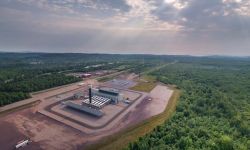Opinion | Why reopen Palisades nuclear plant when we have wind and solar?
I applaud Gov. Gretchen Whitmer and Democratic legislative leaders for addressing the climate emergency in the recent state budget and proposed energy legislation. Their public messaging appropriately emphasizes renewables as they are the fastest and cheapest way to reduce greenhouse gas emissions, entail minimal health and safety risks and have broad public support.

Even though the U.S. nuclear industry has not built a single nuclear plant on schedule or on budget in the last 50 years, the governor and Legislature are also promoting nuclear subsidies, which could strangle renewable investments and raise Michigan’s electricity rates, already the highest in the Midwest. Not surprisingly, they don’t want to admit this to taxpayers and ratepayers.
For example, in the recent state budget, with just two sentences on page 197, Michigan taxpayers will give $150 million to Holtec, which owns the 50-year old Palisades nuclear plant on the Lake Michigan shore.
Closure of the 50-year old Palisades plant in May 2022 had been planned for five years due to its overpriced electricity and need for expensive repairs. Its nuclear fuel was removed over a year ago, and it no longer has an operating license from the Nuclear Regulatory Commission. The governor’s MI Healthy Climate Plan, released in April 2022, reflected Palisades’ imminent closure, and focused on renewables.
But Holtec, in late 2022, saw an opportunity to feed from the public trough by proposing to re-open Palisades. A closed U.S. nuclear plant has never been re-started and, at best, would take several years.
Holtec’s demands include a $300 million blank check from Michigan taxpayers, a state commitment to force ratepayers to pay above-market rates for its expensive electricity (which could total billions of dollars over a 10-year period), and billions of dollars in additional subsidies and loan guarantees from the federal government. The initial $150 million gift to Holtec in the new state budget, added without any analysis or public input, appears to be the first installment of what will be a never-ending stream of state and federal subsidies.
A second example is Michigan House Bill 4759 that was introduced in June. Much media and environmental reaction suggest that it would require 100 percent renewable electricity by 2035. This is incorrect. The bill clearly defines and distinguishes between renewables (solar and wind) and carbon-free (including nuclear in addition to renewables) electricity. Under Section 28, the renewables requirement stabilizes at 60 percent in 2030, while the carbon-free requirement increases to 100 percent in 2035. Nuclear could supply up to 40 percent of Michigan electricity, or about twice today’s level.
Since they have a guaranteed rate of return on their expenses, monopoly utilities love expensive nuclear plants because they generate more profit than cheaper renewable investments.
House Bill 4759 also contains an ominous and unprecedented loophole. Section 52 would allow utilities to charge customers for expenses during power plant construction, long before the plant provides electricity to consumers. This is unimportant for solar and wind installations, which can be built quickly with little chance of failure. But this is a massive ratepayer risk for nuclear plants that can take a decade or more to plan and build, as scores of nuclear white elephants have been abandoned before completion, whereby consumers pay higher rates and get nothing in return.
For example, in the single greatest financial disaster in Michigan history, Consumers Energy spent over $4 billion on the Midland nuclear plant before cancelling it in the mid-1980s without generating a single kilowatt-hour of electricity.
We who want Michigan to be a national climate leader must demand a transparent debate about our future electricity policies. Re-opening the decrepit Palisades plant and building new nuclear plants are simply too slow when we can add solar, wind, and battery installations much more quickly. Because solar and wind are so much cheaper, renewable investments increase the greenhouse gas emissions reductions per dollar relative to nuclear.
In the name of good government and transparency, the governor and legislative leaders must come clean with the public about what they are doing and why they are doing it. If they think that nuclear can provide faster greenhouse gas emissions reductions than renewables, or at a lower cost, then make the case in public and allow a democratic dialogue.
If Michigan taxpayers and ratepayers are given the facts and the opportunity, I am convinced they will demand that their dollars be spent on renewables and not on more nuclear white elephants.
See what new members are saying about why they donated to Bridge Michigan:
- “In order for this information to be accurate and unbiased it must be underwritten by its readers, not by special interests.” - Larry S.
- “Not many other media sources report on the topics Bridge does.” - Susan B.
- “Your journalism is outstanding and rare these days.” - Mark S.
If you want to ensure the future of nonpartisan, nonprofit Michigan journalism, please become a member today. You, too, will be asked why you donated and maybe we'll feature your quote next time!




